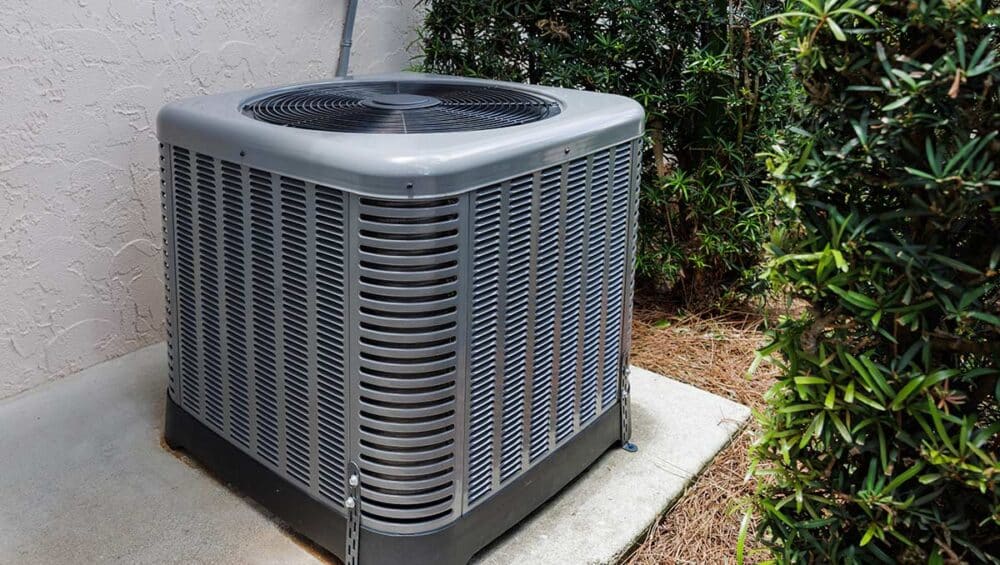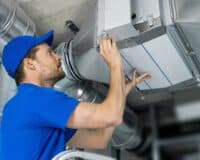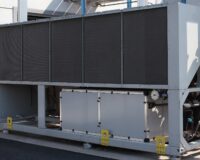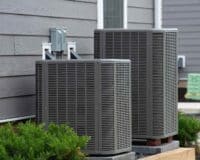No one wants to be stuck inside the heatwave, so when the thermometer begins rising, head for a pool or sit in some shade. Nevertheless, if you want to escape from sweltering weather indoors as well, then an air conditioning unit is absolutely necessary. With it you won’t have to suffer through sweat-soaked days and nights ever again!
When it comes to selecting an air conditioner, there are numerous options available. Stand-alone systems include portable or evaporative models; split systems consist of central and ductless mini-split units that require both interior and exterior components. With all the different options on offer, you can find a system tailored to perfectly suit your home’s needs!
If you’re in the market for an air conditioner, it’s important that you familiarize yourself with all of your options. This guide will help take some of the guesswork out by providing a comprehensive overview on different types of AC systems and their associated costs and efficiency ratings so that you can make an informed decision about what best fits your individual needs and budget.
Central Air Conditioner
When it comes to home cooling, one of the most popular choices is the central air conditioner. This system works by pushing cool air through ducts and outwards from vents in each room – similar to how a furnace efficiently sends hot air throughout your space during winter! With this type of AC, you can enjoy an evenly cooled house year round.
When you’re looking to stay cool and comfortable, central air conditioners are the way to go. These systems can be designed with smart capabilities, enabling you to control your temperature preferences or turn the unit on and off with ease. On average, expect an investment of $4K-8K for both purchase and installation of a new system – but it’ll be worth every penny when summer arrives!
Advantages
Keep your entire home comfortable and cool with our powerful, efficient duct system.
Enjoy a peaceful, serene atmosphere with the quiet indoors operation of this product.
You can conveniently regulate your home’s temperature from your thermostat.
Disadvantages
The initial expenditure for purchase and setup is substantial.
Outdoors elements can often be unappealing and disruptive to the peace and quiet of a neighborhood.
Window Air Conditioner
Is the cost of a central air conditioner holding you back? Consider window-mounted AC units, which offer an economical solution at prices ranging from $100 to just over $1,000 for purchase and installation. These smaller devices fit right into your window with the front indoors and their backs facing outdoors—this allows them to release condensation and heat outside while pushing cooled air inside via built-in fans.
Window air conditioners are perfect for those living in an apartment or condo since they come in various sizes and can even be connected to smart systems, offering the convenience of remote controls. However, it’s essential to make sure these units are properly installed as if not done correctly, they may fall out of windows posing a danger beneath them.
Advantages
With its low upfront cost, simple installation process and remarkable ability to optimize floor space, this is an ideal solution for all of your business needs.
Disadvantages
Installing the unit obstructs your window and produces a loud sound, making it both inconvenient and potentially hazardous.
Smart Air Conditioner
Improve your lifestyle with the new smart home or system compatible air conditioners! With these models, you can conveniently monitor and regulate your AC remotely by simply opening up an app on any of your smartphones or tablets. You’ll be able to switch it off/on, alter temperatures and even create personalized cooling schedules for optimal comfort. Enjoy a smarter way of living today – make sure to check out one of these advanced air conditioning systems!
Smart features have infiltrated every type of air conditioner, from the comparatively inexpensive window and portable models to costly whole-home central ACs. As a result, the cost for purchasing a smart air conditioner can vary significantly – anywhere between $200 and an eye-watering $8,000!
Advantages
With a smart system compatibility, you’re sure to have an expansive selection of options at your disposal. These features not only offer user convenience and accessibility but also increase energy efficiency for maximum benefit!
Disadvantages
Wireless connection is a must for these top-of-the-line smart air conditioner systems, yet the cost can be quite steep.
Ductless Mini-Split Air Conditioner
Are you looking for a way to cool your entire house without extensive ductwork? If the answer is yes, then mini-split air conditioners might be the perfect solution! These convenient systems are ideal if your home has been extended or remodeled after initial HVAC installation, as well as rooms that aren’t frequently used. Mini-splits give you access to cooling power in any part of the house with no need for complex and expensive duct installation.
Before settling on a ductless mini-split air conditioner, it is important to consider that the installation usually runs you between $2,000 and $14,500. A typical system consists of an outdoor condenser unit and a wall-mounted indoor blower linked with refrigerant lines, electrical wiring, and a drain line emptying moisture outside your home.
Advantages
Individualized units ensure that energy costs are kept to a minimum, while simultaneously saving on floor space.
Disadvantages
Not designed to cool enormous spaces or entire homes
Installation costs can be high
Portable Air Conditioner
For those living in apartments or condos, achieving the right temperature inside can be a struggle, especially if the building lacks central air. Window AC units are an excellent option – however they may require professional installation depending on landlord regulations and this could increase your cost significantly.
Portable air conditioners are an incredibly beneficial solution that comes with minimal risks and a relatively low price tag. For as little as $200, you can easily install your portable AC unit in the vicinity of an electrical outlet and window. With its exhaust hose running to a nearby window and built-in fan blowing cool air into the room, this cost effective product is just what you need for those hot summer days! But keep in mind that it does take up some floor space when installed.
Advantages
If you’re looking for a budget-friendly solution, this is it! You’ll have no trouble setting up in apartments, condos or even smaller homes. Plus, the cost won’t break your bank account – saving you time and money!
Disadvantages
With its large size, a vacuum cleaner can consume a significant amount of space in your home. Additionally, it runs noisily when turned on which may be distracting and disruptive.
Through-The-Wall Air Conditioner
Through-the-wall air conditioners are the perfect solution for cooling small areas of your home without relying on ducts, much like a mini-split AC. The main distinction is that rather than connecting through electrical and refrigerant lines to an outdoor unit, these units directly hook up to it.
These units commonly known as floor-mounted air conditioners can be misleading, since they are installed through the wall of your home. The “floor mounted” moniker comes from their usual placement at the bottom of your walls. Unfortunately, though-the-wall air conditioning systems aren’t quite as popular because you must carve a hole to match the size and shape of the unit rather than running a conduit outside for other models.
With its stand-alone design, a through-the-wall air conditioner offers an economical solution when compared to the more expensive mini split system. On average, you can expect to pay anywhere from $850 – $3,000 for purchase and installation of such a unit–a price that’s sure to keep your wallet happy!
Advantages
Located conveniently low, the wall-mounted design of this system ensures that it is easy to reach and use. Furthermore, its indoor operation is surprisingly quiet considering all the benefits you get from such a space saving solution.
Disadvantages
Installing a large hole in the wall enables air circulation, but furniture and other obstructions can impede this process.
Geothermal Air Conditioner
Geothermal air conditioning is an effective and energy-efficient substitute for the traditional central AC system. By pushing cooled air through your home’s existing ducts, this innovative cooling device can lower temperatures throughout the entire residence—even in winter months! While these units are more costly to purchase and install (upwards of $15,000-$35,000), their long-term advantages make them a worthwhile investment: you’ll enjoy significantly reduced energy bills compared to those associated with standard furnaces or central air conditioners.
Geothermal systems are an efficient and effective way to maintain a comfortable home. During winter, the cold water from your house absorbs heat from deep underground – around 10 feet below the surface. This heated water is then brought back into your home where it passes through a compressor that increases its temperature before releasing warm air inside. In summertime, this process works in reverse; with hot air carrying heat out of your home and dissipating it deep down within the soil for optimal cooling effects!
Advantages
Keep your home cool, during even the hottest summer days, with this high-efficiency system that utilizes existing ducts. Not only will its superior cooling power be a relief in extreme temperatures, but it’s guaranteed to last much longer than other types of air conditioning systems – while also helping save money on energy costs!
Disadvantages
An investment up front – both in purchase & installation – is required, making this possibly impractical for those living in apartments or limited-space homes.
Evaporative Air Conditioner
For centuries, people have been using evaporative air conditioners (also known as swamp coolers) to keep their homes comfortable. These systems vary in cost from the most budget-friendly portable units at $100 up to whole-home systems that can reach prices upwards of $7000. Rather than refrigerant cooling like traditional air conditioners, these utilize water or ice instead to provide refreshingly cooled air!
Evaporative air conditioners are advantageous because they use cool water or ice to reduce the temperature of circulating air. However, there is a downside: these systems must be frequently refilled with cold water and/or ice if you have mobile units. In addition, evaporative ACs tend to increase the humidity in your home – making them an unsuitable option for those who already deal with high levels of moisture inside their house.
Advantages
Whether you need a portable unit or an all-encompassing whole home system, our innovative cooling technology is the perfect solution. Not only does it work without harmful chemicals like Freon, but also adds humidity to dry climates for improved comfort and health.
Disadvantages
Although the cooling power of evaporative coolers may not match that of traditional air conditioners, some people experience increased humidity levels which must be monitored. To ensure optimal performance, users should also remember to regularly check and refill ice or water reservoirs.



